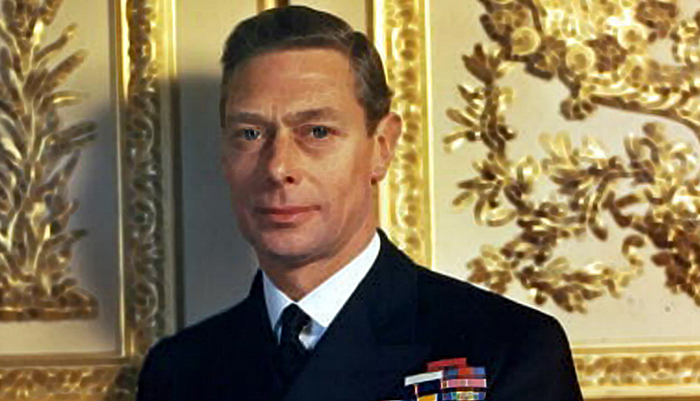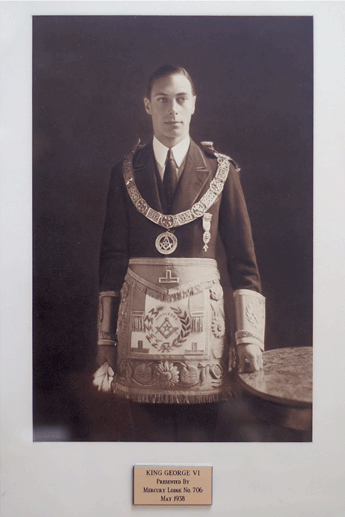
King George VI – The King a Freemason
“The world today requires spiritual and moral regeneration. I have no doubt, after many years as a member of our Order, that Freemasonry can play a part in this vital need”.
The above was written by HM King George VI on 5 November 1951 in a letter to MW Bro Rt Hon the Earl of Scarbrough. His Majesty had promised to install Lord Scarbrough as Grand Master on 6 November, but was prevented from doing so by what proved to be his final illness.
It echoes similar statements he had made on a number of occasions when he attended Grand Lodge as both King and a Past Grand Master. He was in no doubt that Freemasonry was a force for good and had a vital part to play in the life of his country and empire.
The King’s Early Life and Naval Career
Born in 1895 as the second son of King George V and Queen Mary (then Duke and Duchess of York), he seemed destined for a supporting role in Royal and national life. Like many previous younger sons he looked towards a service life and joined the Royal Navy.
When the First World War broke out, unlike his older brother the Prince of Wales, he was allowed to go on active service and saw action at the Battle of Jutland.
Invalided out because of a duodenal ulcer, once that was operated on he determined to get back into uniform and transferred to the Naval Air Service, which was soon to be combined with the Royal Flying Corps to form the Royal Air Force. Although he qualified as a pilot, the King would not allow him to go on raids but he continued on active service until the end of the War.
Although King George V had not been a Freemason, Prince Albert (as he was then styled) knew of the long connection between the Royal House and Freemasonry.
His great-uncle, HRH The Duke of Connaught, was Grand Master 1901-1939, his Grandfather, King Edward VII, had been Grand Master 1874-1901 and in 1919 his brother, the Prince of Wales, was initiated in the Household Brigade Lodge No. 2614.
Prince Albert’s Initiation into Freemasonry
As a Lieutenant in the Royal Navy, Prince Albert sought admission in the Navy Lodge No. 2612, of which his Grandfather had been the founding Master. He was initiated by the Pro Grand Master, Lord Ampthill, in the absence of the Grand Master on 2 December 1919. In response to the toast to the initiate the Prince said:
“I have always wished to become a Freemason, but owing to the war I have had no opportunity before this of joining the Craft. All my life I have heard about Freemasonry, and though there has always been a certain mystery attached to it, I have learned that Freemasons in this country have been a great help to the poor and friendless and have been notable for their efforts on behalf of children. One can see by the great Masonic Institutions and schools how successful their work has been in this cause, and I like to think that in the future I shall be associated in their great work”.
The event was widely reported in the press, as were his subsequent Masonic activities. He became Master of Navy Lodge in 1921 and, following a precedent set by his ancestor King George IV, was to be its permanent Master until he ascended the throne. A shy man with a pronounced stammer, it was remarked by those present that his stammer rarely surfaced when he was involved in ritual. In a personal letter to the secretary of the Navy Lodge, on 2 November 1920, he wrote:
“Greig [his Equerry] told me you were writing to me about the meeting on December 3rd. I hope you will come to see us and put us through our paces again. I have found the passage in the little book. It is not very much to learn”.
Masonic Leadership: From Navy Lodge to Grand Master
The Duke of York, as he was to become, took very much to Freemasonry. He joined five Lodges in addition to Navy Lodge. He was exalted into the Royal Arch on 13 February 1921 in United Chapter No. 1629 (now United Studholme Chapter No. 1591). He and the Prince of Wales joined the Rose Croix in United Chapter No. 169 in 1921 and the Duke was advanced in the Mark in Grand Master’s Mark Lodge No. 1 in 1928.
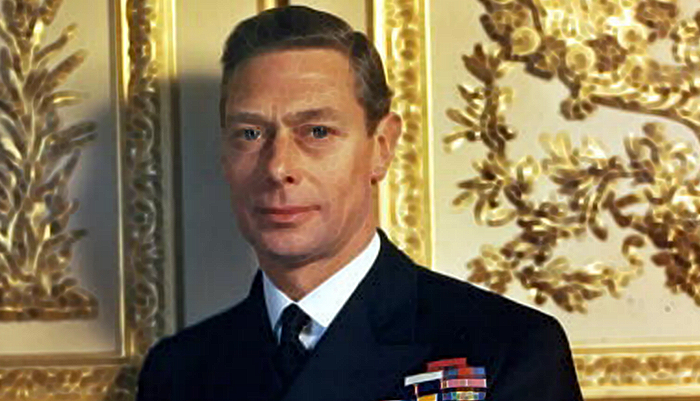
In Grand Lodge he was invested as Senior Grand Warden in 1923 and in 1924 he was installed as Provincial Grand Master for Middlesex, a position he held until he became King.
No mere figurehead, in addition to presiding at the annual Provincial Grand Lodge he took an active part in the life of the Province, the more so after he became the Provincial Grand Master in the Mark.
He took part in consecrations of new Lodges, centenaries and many social events, at all of which he was accompanied by the Duchess (our late and much loved Queen Mother).
To the delight of the Province, in 1934 he accepted the Mastership of Middlesex Masters Lodge No. 3420.
In 1935 the Grand Lodge of Scotland were beginning preparations for the celebration of their bi-centenary. They hoped to celebrate by having a Royal Grand Master Mason, in particular, the Prince of Wales. King George V died in January 1936 and the Prince became King Edward VII and, following precedent, resigned his various Masonic offices. Scotland approached the Duke of York, who was delighted to accept. There was one small problem, however. To be elected Grand Master Mason he had to be a member of a Scottish Lodge.
It is something of the measure of the man that rather than join one of the “society” Lodges in Edinburgh he chose to affiliate to Glamis Lodge No. 99 which met near the ancestral home of his wife. A village Lodge, the Master was one James Beattie, a rural postman attached to the Forfar Post Office.
The Duke was installed as Grand Master Mason of Scotland on 30 November 1936, but his rule was to be short lived. On his return to London the Abdication Crisis came to a head and on 11 December King Edward abdicated, becoming Duke of Windsor, and the Duke of York ascended the throne as King George VI. Following the precedent of his predecessors he resigned all his Masonic offices. The Craft did not wish to lose the connection with one who had been so active in Freemasonry and the suggestion that he be appointed a Past Grand Master was greeted with acclamation.
To celebrate the coronation and to invest the King as a Past Grand Master an Especial Grand Lodge was held at the Royal Albert Hall on 30 June 1937. Sadly, the Grand Master had been taken ill and was unable to attend. The Pro Grand Master, the Earl of Harewood (who was the King’s brother-in-law), welcomed the nearly 8,000 brethren who attended, including deputations from Ireland, Scotland, Canada and the United States.
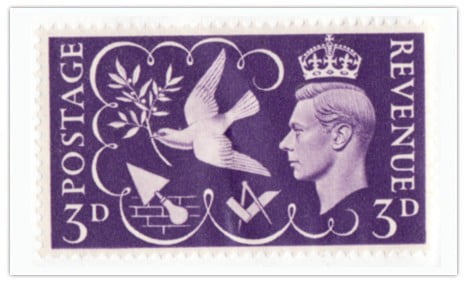
The King entered in procession, to loud and prolonged cheers, and was invested with the collar and jewel of a Past Grand Master. To the great delight of those present, he then took the chair and, on behalf of the Grand Master, invested 130 brethren who had been promoted in, or appointed to, past Grand Ranks in celebration of the coronation. Responding to an address by the Pro Grand Master, the King said:
“… I have, since my initiation in 1919, been greatly interested in my association with Freemasonry. My work as a Provincial Grand Master for over thirteen years and in other directions gave me real pleasure, and I was sorry when it became necessary for me to cease my activities. In this work the Queen also, to whose family connection with the Craft you have alluded, has been interested, and has attended with me various gatherings – for instance the great Festival of the Royal Masonic Benevolent Institution in 1931. Today the pinnacle of my Masonic life has been reached by my investiture at your hands … with the insignia of Past Grand Master, an honour for which I thank you, and which is greatly appreciated …”.
Having been active in the Mark degree, as Senior Grand Warden in 1929 and Provincial Grand Master for the Middlesex Mark Province since 1931, he accepted the rank of Past Grand Master in the Grand Lodge of Mark Master Masons in 1937.
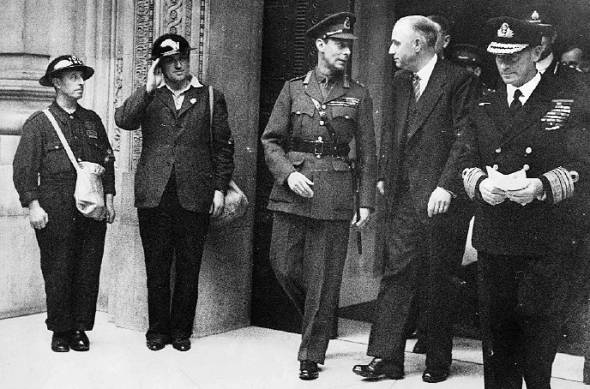
In the Ancient and Accepted Rite he had become an Honorary Member of the Supreme Council when they conferred on him the 33rd Degree in 1932. Surprisingly, in the Royal Arch, although he had been through the three Chairs of his Chapter, he did not take high office, being content to remain a Past Principal.
By time honoured tradition, King George’s appearance in Grand Lodge in 1937 should have been his last formal contact with Freemasonry. Despite himself being a traditionalist, he broke the convention, and on three great occasions appeared as King and Past Grand Master in Grand Lodge.
In 1939 the Duke of Connaught, who had ruled as Grand Master for 38 years, retired. Grand Lodge elected the King’s brother, HRH The Duke of Kent (father of our present Grand Master) to succeed him.
On 19 July 1939 the, at that time, largest ever gathering of Freemasons in England took place when 12,003 brethren met at Olympia in Kensington for an Especial Grand Lodge at which the King took the Chair and installed his brother as Grand Master. In welcoming the new Grand Master the King said:
“This great and representative gathering of recognised Freemasons, who have come from all quarters of the Globe to greet you on his occasion, will indicate the support you may expect in the future. You know that you have my good wishes, and as a Brother Mason, I shall always follow with great interest your rulership of the Craft and the progress of our Order”.
The high hopes of that great meeting were to be short-lived as the new Grand Master was to die tragically in an air accident whilst on war duties with the Royal Air Force in 1942. The installation of his successor, the Earl of Harewood, was to be a more muted affair. On 1 June 1943, just over 1,600 brethren assembled at Freemasons’ Hall in London.
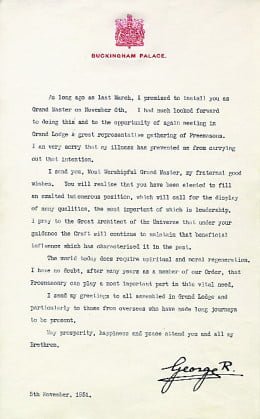
In contrast to the Olympia meeting, wartime conditions limited the delegations form other Grand Lodges to Ireland and Scotland. As the press reported, the entrance into the Grand Temple of the King was greeted by tremendous applause. In the course of his address to the new Grand Master, his brother-in-law, the King said:
“… we have seen how the Brethren have looked to Masonry to provide the moral support and fraternal association which is at all times, and particularly in times of stress, so necessary. I have been most interested to hear how difficulties have been overcome by Brethren in certain areas in their determination to continue their Masonic privileges. … You will appreciate, Most Worshipful Grand Master, that you enter upon the duties of your office at the beginning of perhaps the most critical period in the history of the Craft. English Freemasonry has behind it the experience of nearly two and a half centuries of steadfast adherence to fundamental principles, and I believe that a determination to maintain the values which have been the rock upon which the Masonic structure has stood firm against the storms of the past is the only policy which can be pursued in the future …I thank the Brethren for the warmth of their reception, which has deeply touched me. I cherish my association with the Craft and pray that the GAOTU may continue to pour His Blessings upon it, upon its Grand Master and upon every one of its members.”
Lord Harewood died unexpectedly in May 1947, the King commented:
“The death of Lord Harewood came as a shock to us all. He had carried out the exacting duties of his office, I fear, with entire disregard for his own health”.
The Duke of Devonshire was elected to succeed him and the Royal Albert Hall was again called into service on 23 March 1948 when the King attended to install the new Grand Master. In contrast to the previous occasion, over 7,000 brethren were present with delegations from the United States, Canada and the newly revived Grand Lodges in Europe. In his address to the new Grand Master, the King again stated his belief in the fundamental principles of Freemasonry:
“During the past ten years we have passed through the most devastating war that the world has known, and now all nations are exerting themselves to restore order and prosperity within their frontiers. It is only by the revival of those spiritual and moral values which are always the first victims in war that this rehabilitation can be achieved. With this in view, many men enter Freemasonry today in the belief, which is so fully justified, that it is based on fundamental principles which guide and support them in their endeavours. When I addressed your predecessor at his installation, I said, ‘I believe that a determination to maintain the values which have been the rock upon which the Masonic structure has stood firm against the storms of the past is the only policy which can be pursued in the future’. I think that warning needs emphasising today, when men, sometimes swayed by sentimentality or an indiscriminate tolerance, are apt to overlook the lessons of the past. I cannot better impress this upon you than by quoting from the Book on which we have all taken our Masonic obligations: ‘Remove not the ancient landmark, which thy fathers have set’.”
The King’s death on 6 February 1952 was universally mourned. At the Quarterly Communication of Grand Lodge on 5 March the Deputy Grand Master, the Earl of Derby, summed up the feelings of both the Craft and the people in general when he said:
“I think that for all of us this is a sad occasion, as it is the first time that Grand Lodge has met since the death of His Majesty, our Most Worshipful Brother King George VI. I feel, too, that we all have a deep sense of personal
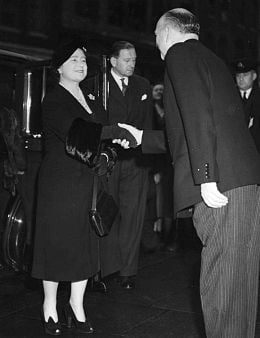
grief at his passing. I do not believe that there was any man who desired Kingship less, or came to the throne under more difficult circumstances, yet we all know that during the years of his reign he was everything we hoped and expected a King to be. I feel that to all of us he set three great examples in a way that we should realise: firstly, in his devotion to duty and in the way that he always set his subjects and his duty before himself; secondly, in his own courage, which he showed during the war years by always sharing the dangers of his subjects, and later by his personal courage during those long months of illness; and lastly, he set us the example of what family life should be”.
From the meeting, messages of condolence were sent to the new Queen, the Queen Mother and to Queen Mary. In a personal response, after thanking the Craft for its condolences and sympathy, HM The Queen Mother wrote:
“His Majesty’s interest in the activities of your Order, to which you have referred, was unfailing and sincere, and I ask you to accept my assurance that this recollection adds very greatly to the value of the message you bring.”
To demonstrate that assurance, on 28 October Her Majesty paid an informal visit to Freemasons’ Hall, spending the greater part of the morning touring the building and viewing the Museum. On her return to her home she selected from the King’s personal collection an 18th century Chinese porcelain bowl with Masonic decoration to be presented to the Museum as a permanent memorial of the King and his connection with the Craft.
Bibliography of King George VI’s Masonic Orders
- Navy Lodge No. 2612
- Initiation: Prince Albert (later King George VI) was initiated into the Navy Lodge No. 2612 on December 2, 1919.
- Role: He later became the Master of the Lodge in 1921 and was known to be its permanent Master until he ascended to the throne.
- Household Brigade Lodge No. 2614
- Association: His brother, the Prince of Wales (later Edward VIII), was initiated into this lodge in 1919, marking a significant familial connection to Freemasonry.
- Royal Arch
- Exaltation: Prince Albert was exalted into the Royal Arch on February 13, 1921, within the United Chapter No. 1629, later known as United Studholme Chapter No. 1591.
- Rose Croix
- Membership: Both he and the Prince of Wales joined the Rose Croix in United Chapter No. 169 in 1921.
- Mark Master Masons
- Advancement: He was advanced in the Mark degree in Grand Master’s Mark Lodge No. 1 in 1928.
- Senior Grand Warden
- Investment: In Grand Lodge, he was invested as Senior Grand Warden in 1923.
- Provincial Grand Master for Middlesex
- Installation: Installed as Provincial Grand Master for Middlesex in 1924, a position he held until becoming King.
- Middlesex Masters Lodge No. 3420
- Mastership: Accepted the Mastership of this Lodge in 1934.
- Grand Master Mason of Scotland
- Affiliation: Affiliated to Glamis Lodge No. 99 to qualify for the position of Grand Master Mason of Scotland, into which he was installed on November 30, 1936.
- Past Grand Master
- Honorary Position: Following his ascension to the throne as King George VI, he was appointed a Past Grand Master, an honor celebrated at a special Grand Lodge meeting at the Royal Albert Hall on June 30, 1937.
This bibliography reflects King George VI’s deep involvement in various aspects of Freemasonry, from local lodge membership to national leadership roles, showcasing his commitment to the organization’s principles and activities throughout his life.
